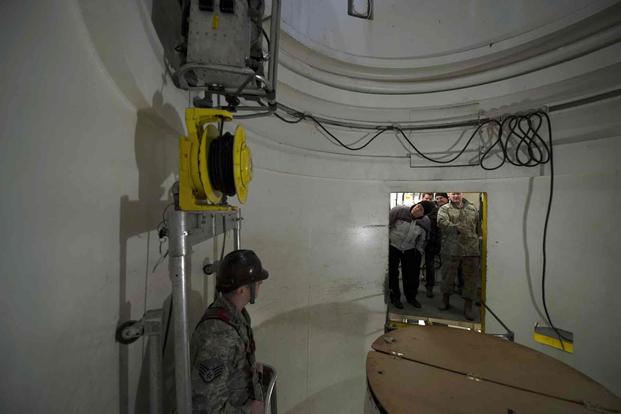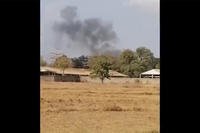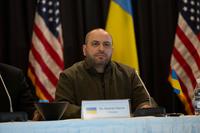Test results from a survey of Minot Air Force Base in North Dakota found elevated levels of PCBs -- chemical compounds that likely cause cancer -- at the nuclear missile installation, according to the Air Force.
Minot was the last site surveyed by the Air Force as part of its probe into health and cancer concerns among America's missileers at three installations in the continental U.S. A previous survey also found elevated levels of PCBs at Malmstrom Air Force Base in Montana.
The surveys came after a Space Force officer raised alarm earlier this year about cases where missileers who had been stationed at Malmstrom during their careers were diagnosed with cancer, prompting the Air Force to undergo a new study investigating a potential connection at all of America’s intercontinental ballistic missile bases.
Read Next: After Years of Delays, Army Releases New Suicide Prevention Plan Short on Answers
The U.S. Air Force School of Aerospace Medicine and the Defense Centers for Public Health collected air and swipe samples from launch control centers and launch control equipment buildings at all three ICBM bases -- Minot, Malmstrom and F.E. Warren Air Force Base in Wyoming, which was not found to have elevated levels of PCBs.
Findings released Thursday from Minot Air Force Base showed that of the 300 surface swipe samples taken, 30 found detectable levels of polychlorinated biphenyls, banned chemical compounds commonly known as PCBs, that were used in building and electrical materials.
Two of those samples were above the threshold set by the Environmental Protection Agency, according to a news release.
Production of PCBs was outlawed in the U.S. by the Toxic Substances Control Act of 1976.
Overexposure to those oily substances in animal studies has been tied to a range of serious health conditions, according to the federal Agency for Toxic Substances and Disease Registry.
On Tuesday, Air Force Global Strike Command released results from F.E. Warren Air Force Base. "Of the 300 surface swipe samples, 17 found detectable levels of PCBs," according to the command. Those were considered below the threshold set by the EPA.
Earlier this month, the command announced the carcinogens were detected at elevated levels in two launch control centers and missile alert facility sites at Malmstrom in Montana after taking 300 surface samples from across the base.
"Of the swipes, 279 returned non-detectable results. Of the 21 with detectable results, 19 were below the mitigation level established by federal law and regulation," it said in a press release.
Air samples at each base taken for airborne PCBs came back negative. Ground and water results from all of the ICBM bases are still being processed.
The Space Force officer who first raised the alarm of health and cancer concerns among missileers did so in a presentation early this year at Schriever Space Force Base, Colorado. He detailed 36 cases in which missileers who had been stationed at Malmstrom during their careers were diagnosed with cancer.
Ten of the airmen who have received cancer diagnoses, according to his briefing, developed non-Hodgkin lymphoma. Two developed Hodgkin lymphoma, and 24 developed another form of cancer. Overall, eight of the 36 missileers with cancer diagnoses -- the majority of whom served at Malmstrom sometime between 1997 and 2007 -- have died.
This is not the first time the military has investigated a link between missileer service and cancer clusters.
In 2001, the Air Force Institute for Operational Health did a site evaluation and sampled for potential chemical and biological contaminants at Malmstrom after cases of various cancers from missileers were reported, including cervical cancer, thyroid cancer, Hodgkin lymphoma and two cases of non-Hodgkin lymphoma in which those patients died, according to a report issued in 2005.
The Air Force said in 2005, following the release of the report, that "there is not sufficient evidence to consider the possibility of a cancer clustering to justify further investigation" and that "sometimes illnesses tend to occur by chance alone."
But the Air Force Medical Service, which is conducting the new "Missile Community Cancer Study," now says those conclusions may be outdated. Under a frequently asked question section on the service's website, the office says that the findings from two decades ago may have changed.
"We acknowledge time has passed and have the responsibility to investigate any potential service-related risks to airmen, Guardians or their dependents' health," the website says. "We take this responsibility seriously."
The Torchlight Initiative, a nongovernment organization composed of current and former ICBM community members and their families, has a self-reported registry in which 268 current and former service members or their surviving family members tied to ICBM bases have reported cancer, diseases or illnesses.
So far, 217 of those cases are cancer and 33 are non-Hodgkin lymphoma. Roughly 46% of those self-reported cases are from those who served at Malmstrom Air Force Base.
Gen. Thomas Bussiere, Air Force Global Strike commander, has directed cleanup of the PCBs at all three ICBM sites where the chemical was detected.
It is unclear whether missileers would be displaced from their routine workspaces.
Capt. Lauren Linscott, an Air Force Global Strike Command spokesperson, told Military.com earlier this month that cleanup policies and procedures are being implemented by the workforces at those bases.
If resources for thorough cleanup and mitigation can't be provided by the bases, those services may be contracted out.
"We are currently partnered with bioenvironmental and medical teams from across the Air Force to determine their capacity for cleanup," Linscott said in an Aug. 10 email. "If they are unable, we expect to look for contract assistance."
-- Thomas Novelly can be reached at thomas.novelly@military.com. Follow him on Twitter @TomNovelly.
Related: Carcinogen Test Results at 2 More Nuclear Missile Bases Expected in 2 Months













